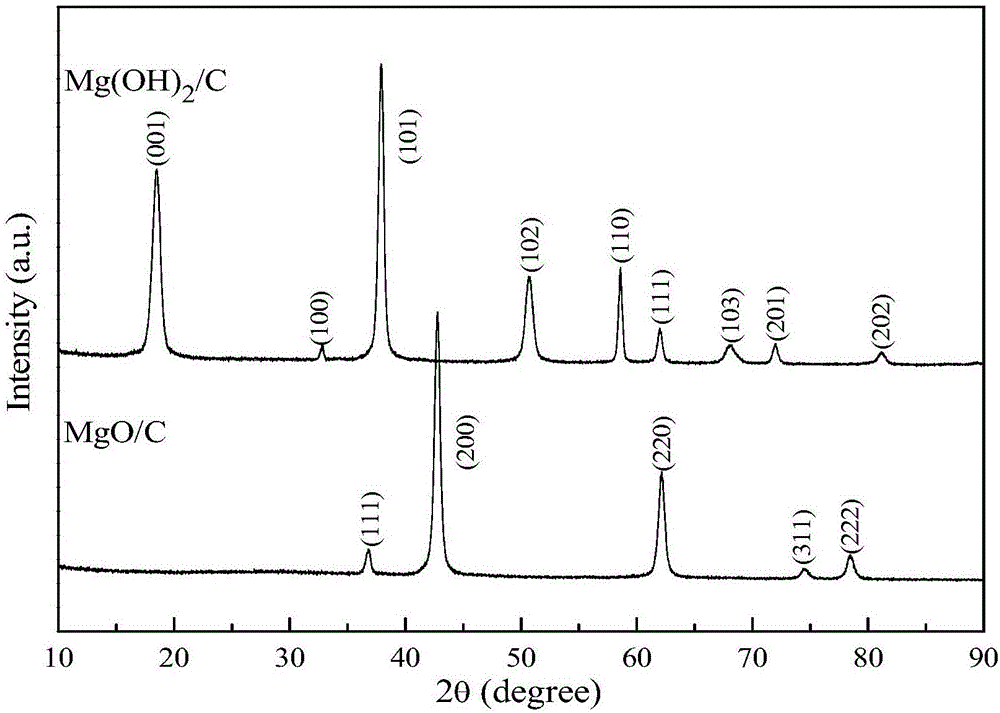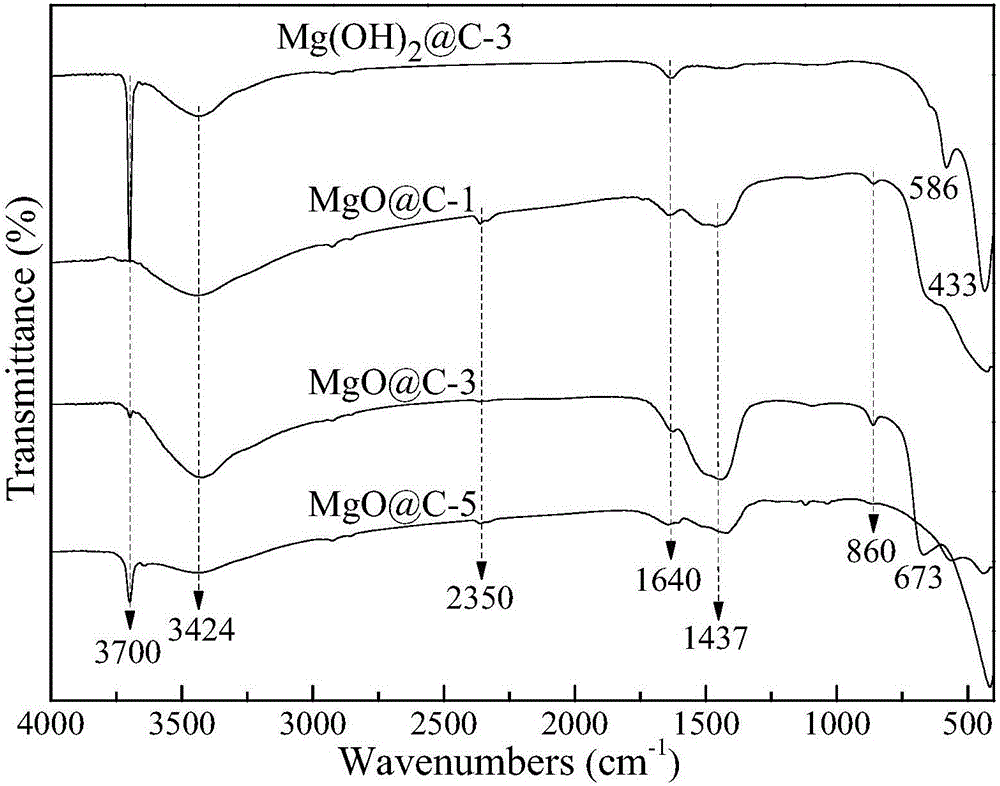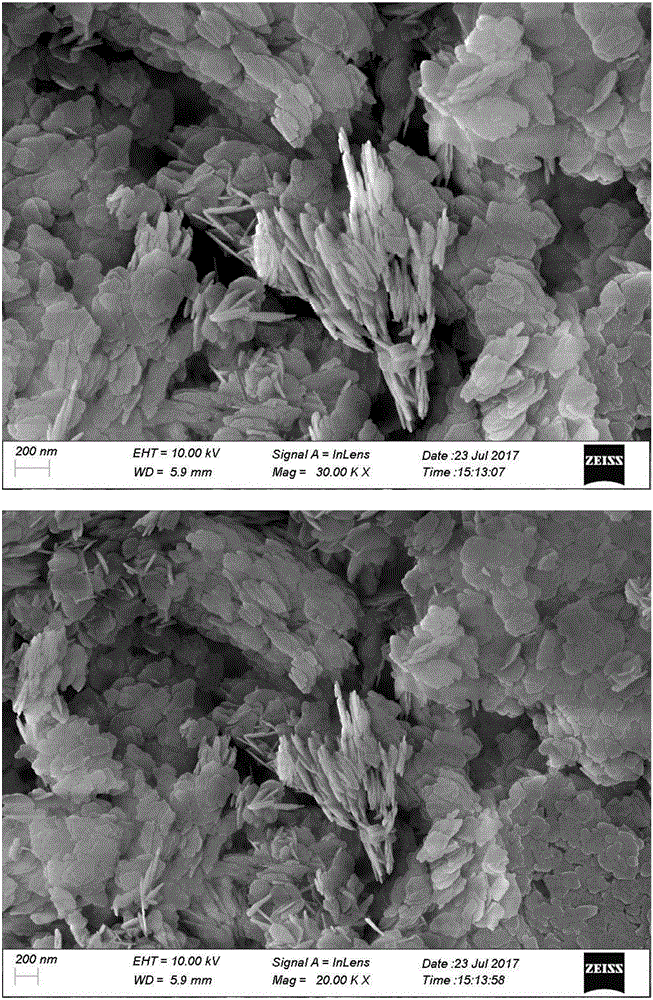Sandwich-structured nano-adsorbent of carbon-coated magnesium oxide and preparation method thereof
A carbon-coated magnesium oxide, nano-adsorption technology, applied in chemical instruments and methods, adsorbed water/sewage treatment, other chemical processes, etc., can solve the problems of low adsorption rate, difficult collection of nano-MgO, hindering the process of industrial application, etc. , to achieve the effect of strong adsorption capacity, long service life and low cost
- Summary
- Abstract
- Description
- Claims
- Application Information
AI Technical Summary
Problems solved by technology
Method used
Image
Examples
Embodiment 1
[0032] Weigh 5.1g of magnesium chloride hexahydrate, 1.23g of glucose monohydrate, and 1.0g of polyvinylpyrrolidone (Mw=58000) into 100mL of 50% ethanol solution, and stir at a constant temperature of 25°C and a stirring speed of 500r / min for 20min to form a magnesium salt solution. 5mL ammonia water (analytical grade, NH 3 content of 15%-28%) was added to the magnesium salt solution at a constant speed, and stirred at a constant temperature for 120 minutes at a temperature of 25° C. and a stirring speed of 450 r / min to form a magnesium salt slurry. The slurry was hydrothermally reacted at 170°C for 24 hours, washed by centrifugation, dried in vacuum and heated under N at a temperature of 500°C. 2 The carbon-coated MgO sandwich structure composite nanomaterial was obtained after flow-through calcination, denoted as MgO@C-1.
Embodiment 2
[0034] Weigh 5.1g of magnesium chloride hexahydrate, 4.92g of glucose monohydrate, and 2.0g of polyvinylpyrrolidone (Mw=58000) into 150mL of 50% ethanol solution, and stir at a constant temperature of 25°C and a stirring speed of 500r / min for 20min to form a magnesium salt solution. 5mL ammonia water (analytical grade, NH 3 content of 15%-28%) was added to the magnesium salt solution at a constant speed, and stirred at a constant temperature for 120 minutes at a temperature of 25° C. and a stirring speed of 450 r / min to form a magnesium salt slurry. The slurry was hydrothermally reacted at 170°C for 24 hours, washed by centrifugation, dried in vacuum and heated under N at a temperature of 500°C. 2 The carbon-coated magnesium oxide sandwich structure composite nanomaterial was obtained after flow-through calcination, which was denoted as MgO@C-2.
Embodiment 3
[0036]Weigh 10.2g of magnesium chloride hexahydrate, 2.46g of glucose monohydrate, and 2.0g of polyvinylpyrrolidone (Mw=58000) into 150mL of 50% ethanol solution, and stir at a constant temperature of 25°C and a stirring speed of 500r / min for 30min to form a magnesium salt solution. 10mL ammonia water (analytical grade, NH 3 content of 15%-28%) was added to the magnesium salt solution at a constant speed, and stirred at a constant temperature for 150 minutes at a temperature of 25° C. and a stirring speed of 450 r / min to form a magnesium salt slurry. The slurry was hydrothermally reacted at 150°C for 18h, washed by centrifugation, dried in vacuum and heated under N at a temperature of 500°C. 2 Sandwich structure composite nanomaterials of carbon-coated MgO were obtained after flow-through calcination, denoted as MgO@C-3.
PUM
| Property | Measurement | Unit |
|---|---|---|
| clearance rate | aaaaa | aaaaa |
Abstract
Description
Claims
Application Information
 Login to View More
Login to View More - R&D
- Intellectual Property
- Life Sciences
- Materials
- Tech Scout
- Unparalleled Data Quality
- Higher Quality Content
- 60% Fewer Hallucinations
Browse by: Latest US Patents, China's latest patents, Technical Efficacy Thesaurus, Application Domain, Technology Topic, Popular Technical Reports.
© 2025 PatSnap. All rights reserved.Legal|Privacy policy|Modern Slavery Act Transparency Statement|Sitemap|About US| Contact US: help@patsnap.com



